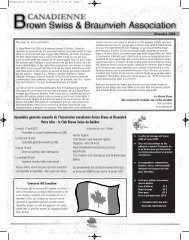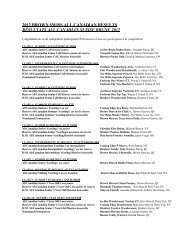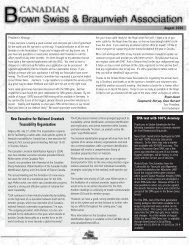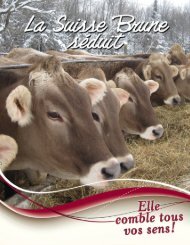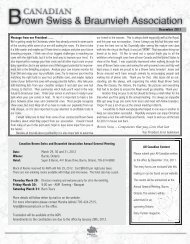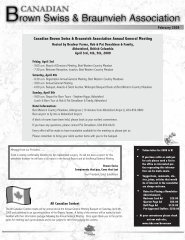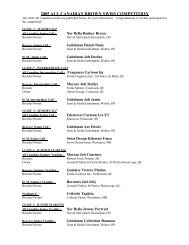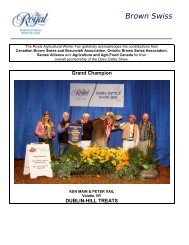A little history - Canadian Brown Swiss & Braunvieh Association
A little history - Canadian Brown Swiss & Braunvieh Association
A little history - Canadian Brown Swiss & Braunvieh Association
You also want an ePaper? Increase the reach of your titles
YUMPU automatically turns print PDFs into web optimized ePapers that Google loves.
A <strong>little</strong> <strong>history</strong>...Probably the oldest of the dairy breeds, <strong>Brown</strong> <strong>Swiss</strong> descended from cattle used in thevalleys and mountain slopes of Switzerland since before historic records began. It was here thatthe transmitting ability of certain breed characteristics became so firmly established that they arestill prominent today.The <strong>Brown</strong> <strong>Swiss</strong> breed is possibly the purest of all recognized breeds of dairy cattle. It is believedthere was <strong>little</strong> or no infusion of foreign blood, and no apparent crossing with other cattlethroughout the establishment of the breed. So well fixed did the characteristics of the breedbecome, and so apparent was the prepotency and vigour of the animals, that cattle raisersfrom Germany, Italy, and other surrounding domains made regular importations of <strong>Swiss</strong> stock tostrengthen the productive quality of their herds.The first <strong>Brown</strong> <strong>Swiss</strong> in Canada were imported tothe Eastern townships of Québec from the UnitedStates in 1888. Although considered a dual-purposebreed (dairy and beef) in Europe, pioneer NorthAmerican breeders recognized their great potentialfor milk production and concentrated their effortsfor improvement in the direction of developing adairy cow. <strong>Brown</strong> <strong>Swiss</strong> are now found throughoutCanada.The original characteristics including size, ruggedness,strong sound feet and legs that wear, quality udders thatlast, and have been maintained and improved. Thesequiet, docile tempered cows are ideally suited for eitherthe family-sized farm or the large commercial operation inany climate. <strong>Brown</strong> <strong>Swiss</strong>, being hardy and rugged, performwell in all climates and at all altitudes.<strong>Brown</strong> <strong>Swiss</strong>,the complete package!<strong>Brown</strong> <strong>Swiss</strong> are found throughout Canada presently and many <strong>Canadian</strong>animals are sold to foreign buyers. The beef aspect of the big brown cowwas developed in the late 1960s and early 1970s during the “exotic” beefrush. These beef focused animals are known as <strong>Braunvieh</strong>. <strong>Braunvieh</strong> is aGerman term which translates to “brown cattle”. Since they were of thesame original genetic stock as the <strong>Brown</strong> <strong>Swiss</strong>, they were entered into the<strong>Brown</strong> <strong>Swiss</strong> herd book.Within the <strong>Canadian</strong> <strong>Association</strong> we have 5 provincial associations. Theheaviest population of <strong>Brown</strong> <strong>Swiss</strong> reside in Ontario and Québec, withManitoba starting to make a significant increase in the interest and sale of<strong>Brown</strong> <strong>Swiss</strong> to other breeders. At present, <strong>Brown</strong> <strong>Swiss</strong> interests continuesto grow and expand with breeders of other dairy cattle.• Are you looking for adairy breed offering acow that produces highquality milk?• Do you want to benefitfrom her long productivelife to make your herdprofitable?• Are you looking for acow with a quiet anddocile temperament, whototally adapts to allbreeding conditions?3



